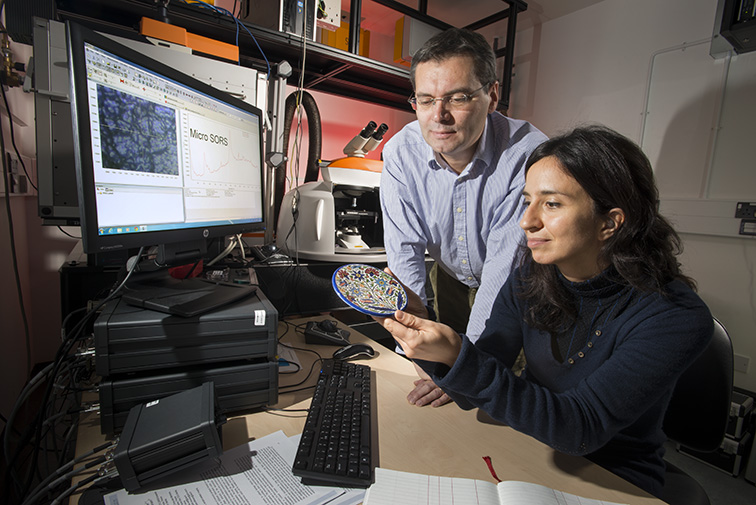The results, published in the journal Analytical Chemistry, provide new opportunities for cultural heritage research, often where heterogeneous layers are found within painted stratigraphies.
Last weekend saw the return of the annual Oxford International Art Fair where artists from all four corners of the globe showcased their incredible paintings, sculptures and bespoke crafts. Crowds gathered to marvel upon the displayed art, a phenomenon that humans have been entranced with for centuries. From Van Gogh to Leonardo da Vinci, paintings have long formed part of our culture and heritage. But can we investigate these marvels a little further and can science help us uncover the hidden messages found within some of our most prestigious paintings? What if we could traverse time and uncover the internal dynamics of these illustrious masterpieces? The answer lies with laser technology.
The process of Raman scattering was first discovered by Indian physicist C.V.Raman in 1928. It allows scientists to discover the chemical composition of a material by studying the vibration of the atoms within it. Molecular spectroscopy based on the Raman Effect is known as Raman spectroscopy and is the basis of SORS, or Spatially Offset Raman Spectroscopy. SORS was invented at the Science and Technology Facilities Council's (STFC) Rutherford Appleton Laboratory at the Central Laser Facility.The technology developed using this technique went on to become so profitable that a new spin-out company, Cobalt Light Systems Ltd, was created with the sole purpose of marketing SORS technology. SORS provides a method by which one can identify the chemical composition underneath the surface of materials ranging from skin to liquids in bottles. Whilst traditional methods such as cross-sectional analysis using Raman spectroscopy can provide detailed information about chemical makeup, with some pieces of art that hold high cultural value, this destructive technique is evidently not the best option.
In recent times, a new technique based on the Raman concept - but with significantly higher penetration depth - has emerged. If you combine SORS with the power of microscopes, you get a handy little technique known as Micro-Spatially Offset Raman Spectroscopy, or Micro-SORS for short, developed by the teams of the Italian National Research Council (ICVBC-CNR) and CLF. As it has very high chemical specificity, micro-SORS is often used for the characterisation of surface layers of paints in art. Not only that, but the technique has come in very handy for the study of hidden images and writings as it can determine overlayer depth, reject overlayer fluorescence and permit two-dimensional mapping of thin materials.
In this experiment, scientists from the CNR and CLF studied two-layer paint systems where either each or both layers were heterogeneous, that is they were made up of more than one type of material, in this case, paint. Using micro-SORS technology, the team were able to obtain informative data on the overall chemical makeup of the sample. They then tested the behaviour of micro-SORS signals under different scenarios. In order to do so, the team plotted the ratio of the top layer signal over the sublayer signal as a function of defocusing distance for each of the two subsurface components from data obtained by mapping on scales substantially larger than the scale of heterogeneity. This approach provided an effective means of obtaining robust and representative micro-SORS datasets from which sample composition could be effectively deduced, even in the extreme scenarios of high heterogeneity.
“Often paints have high turbidity which means that conventional imaging techniques struggle to investigate deep inside them. Micro-SORS on the other hand enables deeper access with intact Raman technique avoiding controversial traditional invasive cross-sectional analysis on objects of art."
Dr Claudia Conti (CNR)
The analysis of paint samples is not the only application of this research, however. In fact, this technique is very applicable to a wide range of areas including - but not limited to - polymer research, forensics and biological fields. Whilst the paper does raise concerns about the effectiveness of micro-SORS with highly heterogeneous samples, informative data on the overall chemical makeup of the sample in the team's experiment was successfully obtained. What this means is that micro-SORS is quickly becoming a valuable tool for non-invasively investigating the chemical composition of subsurfaces and thus providing detailed insight into turbid layers such as those found in paintings.

Figure 1: Professor Pavel Matousek (CLF) and Dr Claudia Conti (CNR)
The full publication is available to view in Analytical Chemistry
For further information about the research, please contact Dr Claudia Conti (c.conti@icvbc.cnr.it)
To read more news releases concerning the CLF, please visit CLF News
